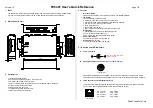
INDUSTRIAL I/O PACK SERIES
AVME9675A
VME64x bus 6U CARRIER BOARD
Acromag, Inc. Tel: 248-295-0310
- 34 -
http://www.acromag.com
- 34 -
https://www.acromag.com
3.10 GENERAL PROGRAMMING CONSIDERATIONS
The carrier board register architecture makes the configuration fast and
easy. The only set of configuration hardware jumpers is for the base
address of the carrier board in the VME64x bus short I/O space. Once the
carrier board is mapped to the desired base address, communication with
its registers and the I/O and ID spaces of the IP modules is straightforward.
The carrier board is easily configured to communicate with IP memory
space, if present, through two configuration registers. Interrupt
configuration/control, if supported by IP modules, is also easily done
through registers.
3.11 Board Diagnostics
The board is a non-intelligent slave and does not perform self-diagnostics. It
does, however, provide front panel LED's to indicate successful
communication with each of the four IP modules, A through D. These LED's
are driven by the corresponding IP acknowledge signal which is lengthened
by the logic in the FPGA on the carrier board to make the access visible to
the user. This means that frequent accesses to an IP will result in constant
LED illumination. The LED's indicate I/O, memory, interrupt acknowledge,
and ID space accesses. Note that the LED's will not illuminate during
accesses of carrier board registers, or accesses to IP modules which are not
physically present, or to unsupported memory space. Additional
information about the error status of the IP modules can be obtained by
reading the IP Error Register.
3.12 GENERATING INTERRUPTS
Interrupt requests do not originate from the carrier board, but rather, from
the IP modules. Each IP may support 0, 1, or 2 interrupt requests. The
carrier board processes the request from the IP and uses the Interrupt Level
Register data to map the request to the desired VME64x bus interrupt level
(if locally enabled within the Interrupt Enable Register and globally enabled
within the Carrier Board Status Register). The carrier board then waits for
an interrupt acknowledge from the VME64x bus host after asserting the
appropriate VME64x bus interrupt request.
When the carrier board recognizes an interrupt acknowledge cycle on the
VME64x bus, it checks for a match of the IP interrupt requests. If none is
pending or the interrupt level does not match, it will pass the
acknowledgment signal along, without consuming it. If there is a match, the
carrier board will initiate an acknowledgment cycle with the requesting IP,
which must supply the interrupt vector during the cycle. The VME64x bus
















































